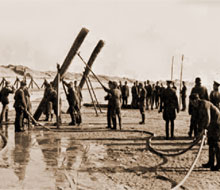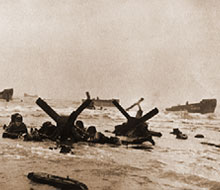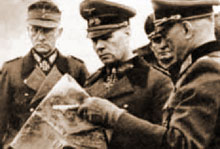The Germans on Omaha
On the beach





- Diameter: 12.5 inches.
- Height: 3.5 - 4 inches.
- Weight: 17 - 20 lbs.
- Igniters: T.Mi.Z. 42.
- Trigger Weight: 240 - 400 lbs.
- Explosive Charge: 11 lbs. TNT.
Omaha Beach was heavily protected by the Atlantic defences and excellent terrain for defence.
Moving out from the dunes toward the sea, the first obstacles encountered were called hedgehogs. They were three steel bars welded or bolded together at the centre tipping the edge in the air. Those were four to five feet long.
Mixed with the hedgehogs was tetrahedron. Those elements were concrete triangles sometimes five to six feet high. The third set of obstacles was logs set in the sand at a ninety to forty five degrees angle towards the sea.
Other logs (tree trunks) faced back toward the land forming a ramp with metal teeth to wreck the landing craft.
The last heavy element was the Belgium gate, a large metal structure to stop the traffic on the beach. Most of those elements were equipped with teller mines.


German defender equipment
They had 8 concrete bunkers, 6 with 75 m/m guns and 2 with 88 m/m guns, 35 pillboxes with artillery or other automatic weapons, 18 antitank guns, 6 mortar pits, 35 rocket-launching sites, each with 4 rockets and at least 85 machine gun positions.
Also, 20 heavier guns, 105 m/m howitzer and 155 m/m were in land use to cover the beach. Some of those sites are still obvious today and can be visited but most of them were covered over after the war. These positions were called WN by the Germans (Widerstandnest).

General Rommel (center) on his inspection tour of the beach defences in the 84th Army Corps Zone. General Marcks is seen standing to the left.
Omaha was under the range of 20 of those WN from WN 56 to WN 76, each separate position containing from 7 to 35 men. To reinforce those structures, were set up on each beach exit (Stützpunkt) containing about 70 soldiers, many of those construction were linked with underground passages , tunnels or trenches.
German units
On D-Day, the 2nd Bn of the 916th Infantry Regiment was close by Vierville and the 3rd Bn of the 726th in the area of Colleville. A German infantry Bn contained 708 men.
The 352nd Division Commander, Major Kraiss did not trust the 726th and assigned an additional Bn of the 916th as reserve near Colleville. Major Pluskat HQ was headquartered at Etreham.